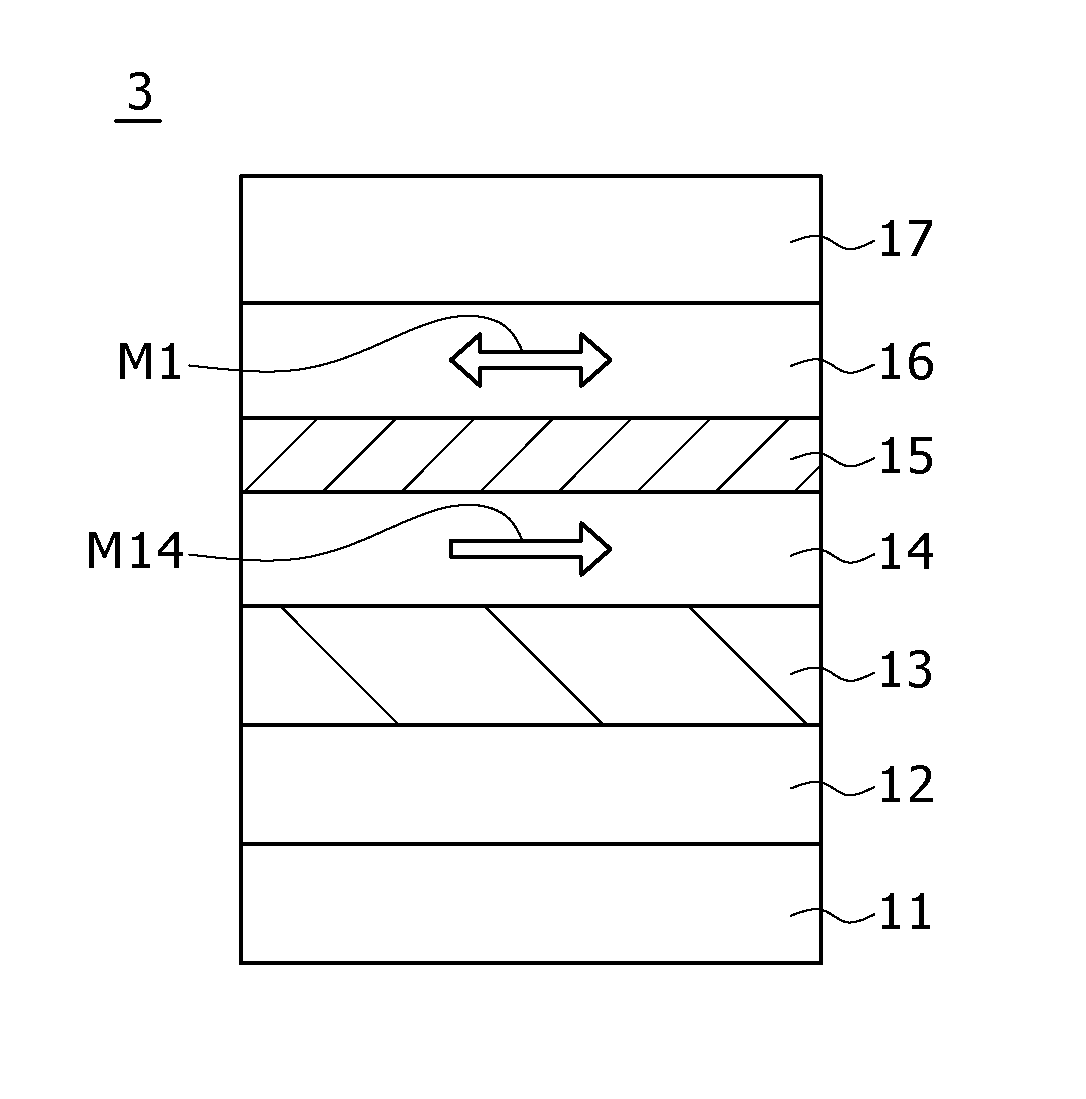Storage element, method for manufacturing storage element, and memory
a storage element and manufacturing method technology, applied in the field of storage elements, can solve the problems of lowering resistance, difficulty in operation without application, and lowering the quality of the tunnel barrier layer, and achieve the effect of reducing power consumption, reducing resistance, and sufficient flatness
- Summary
- Abstract
- Description
- Claims
- Application Information
AI Technical Summary
Benefits of technology
Problems solved by technology
Method used
Image
Examples
first embodiment
1. First Embodiment of the Present Disclosure
Configuration Example of Memory
[0038]FIG. 1 is a schematic configuration diagram (perspective view) of a memory according to a first embodiment of the present disclosure.
[0039]This memory is formed by disposing storage elements capable of retaining information based on the magnetization state near the intersections of two kinds of address interconnects (e.g. word line and bit line) orthogonal to each other.
[0040]Specifically, in part isolated by an element isolating layer 2 in a semiconductor substrate 10 such as a silicon substrate, a drain region 8, a source region 7, and a gate electrode 1 are formed as a selection transistor for selecting the corresponding memory cell. The gate electrode 1 serves also as one address interconnect (e.g. word line) extended along the anteroposterior direction in the diagram.
[0041]The drain region 8 is formed in common to the selection transistors on the left and right sides in the diagram. An interconnec...
experimental example 1
[0084]A 5-nm-thick Ta layer was formed as the base layer 12 on a silicon substrate with a thermally-oxidized film. Next, a 20-nm-thick PtMn layer was formed as the antiferromagnetic layer 13, and 2-nm-thick CoFe / 0.8-nm-thick Ru / 2-nm-thick CoFeB layers were sequentially formed as the magnetization pinned layer 14. In this example, a spin valve structure made by utilizing the antiferromagnetic layer 13 was used, and a synthetic ferrimagnetic structure made with the intermediary of Ru was used as the structure of the magnetization pinned layer 14.
[0085]Next, as the tunnel barrier layer, a 0.4-nm-thick MgO layer was formed in a first step and then a 0.07-nm-thick MgO layer for the remaining thickness was formed in a second step. At last, a 3-nm-thick CoFeB layer as the free magnetization layer and a cap layer were sequentially formed. After the multilayer body having the above-described configuration was formed, magnetic field heat treatment was performed at 320° C. Through the above-de...
experimental examples 2 to 4
[0086]MTJ elements of experimental examples 2 to 4 were fabricated by the same method as that of experimental example 1 except for that the thickness of the MgO layer formed in the second step for forming the tunnel barrier layer was set to 0.13 nm, 0.19 nm, and 0.23 nm, respectively. In the MTJ elements of experimental examples 2 to 4, the thicknesses of the tunnel barrier layer were 0.53 nm (experimental example 2), 0.59 nm (experimental example 3), and 0.63 nm (experimental example 4).
(Comparison of Magnetization Curve)
[0087]FIG. 4 shows magnetization curves of the storage layer about the respective fabricated samples of the MTJ elements of experimental examples 1 to 4. In FIG. 4, the abscissa indicates the applied magnetic field H [Oe] and the ordinate indicates the magnetization M [a. u].
[0088]The elements of experimental examples 1 to 4 exhibited favorable squareness attributed to planarization of the tunnel barrier layer.
[0089]In experimental example 4, in which the thickness...
PUM
 Login to View More
Login to View More Abstract
Description
Claims
Application Information
 Login to View More
Login to View More - R&D
- Intellectual Property
- Life Sciences
- Materials
- Tech Scout
- Unparalleled Data Quality
- Higher Quality Content
- 60% Fewer Hallucinations
Browse by: Latest US Patents, China's latest patents, Technical Efficacy Thesaurus, Application Domain, Technology Topic, Popular Technical Reports.
© 2025 PatSnap. All rights reserved.Legal|Privacy policy|Modern Slavery Act Transparency Statement|Sitemap|About US| Contact US: help@patsnap.com



